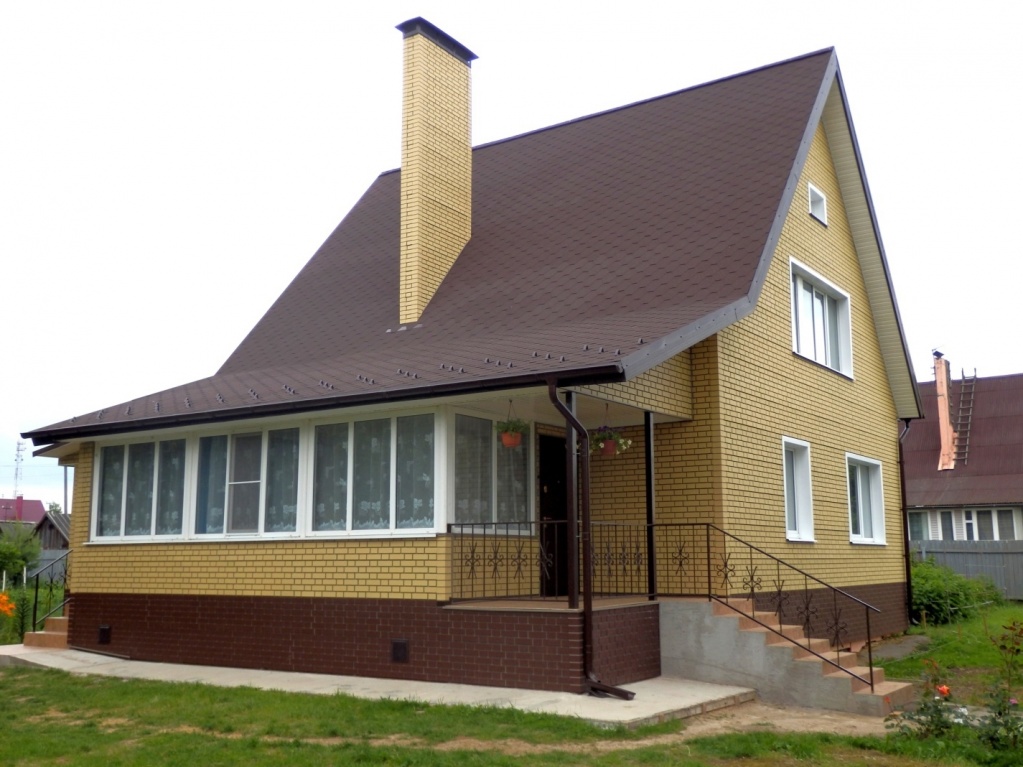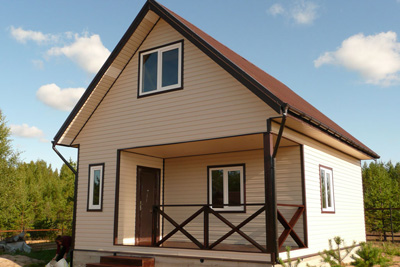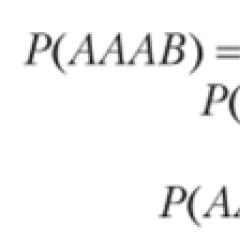Inexpensive facade material for the house. What material to choose for facing the facade of the house
The facade of almost any house needs additional finishing. The only exceptions are wooden mansions made of solid or glued beams. Choosing a cladding option, the owner is based on his preferences and financial investments. However, the variety of materials gives a lot of food for thought, because the facade cladding should perform a lot of functions: durable, practical, beautiful. Therefore, you should first familiarize yourself with all the options and possibilities, and only then choose something more expensive, or vice versa, economical and affordable to do it yourself.
Competent approach to the choice of material
It should be noted right away that good material won't be cheap. You can save on reducing the costly part in terms of performing work, as well as choosing products that are distinguished by high practical properties and workability. In this case, repairs and refurbishment will not be required for a long time, and this is a direct cost reduction.
Having paid attention to the finished facade, we take into account the following factors:
- How ugly the unfinished surface looks. If this wooden walls, then for a couple of years they will retain their attractiveness, but then they will darken, which means that they may also have to be trimmed.
- The number of sunny days per year also matters, as does the frequent rainfall. In the process of exposure to the external environment, the material will burn out, be saturated with moisture. Therefore, the selection of cladding will take place taking into account these indicators. It is even important whether the house is on a lighted empty plot or is fenced off on one side by neighboring buildings.
- When thinking about purchasing an imitation product, it is worth comparing its similarity with natural raw materials. For example, the basement of the house is made of stone; I would like the facade to look like a stone too. And here the compatibility of the color scheme will "play".
- Texture and color variability of the material. For example, if it is a natural stone, then the variety of textures and colors is limited, but siding allows you to choose shades without any restrictions.
Important! In any case, the cladding must be durable. But there is a danger of moral obsolescence, therefore, for a solid structure, the service life of which is more than 10-15 years, it is better to choose practical, but discreet materials.
When choosing a finishing material, do not give preference to the cheapest one, this threatens with a constant renovation of the cladding. Now let's look at the advantages, disadvantages and characteristics various products.
Panels

Today there are two types of products: polyplan and sandwich panels.
- Polyplane is a multi-layer structural panel with a lacquered aluminum top layer, polyurethane foam filling and a foil layer. The advantages of the product are the ideal protection of walls from steam and heat. Sheets are fastened vertically using the locking profiles with which they are equipped. The joints are minimal, so water and snow do not get into the cracks. The disadvantage is the high cost of finishing, although the polyplane serves for a long time.
- Sandwich panels - more cheap stuff... The three-layer structure has a "cladding" with metal sheets, between which a heater is laid. The production includes a hot-pressing process, which minimizes the risk of delamination of the "pie", which is why sandwich panels are considered one of the simplest and most affordable finishing options. In this case, the facade cladding is carried out independently.
Important! When choosing sandwich panels, it is necessary to clarify the quality of the insulation. The higher the coefficient of thermal conductivity, the more heat will leave the house.
Panels of any type can have a smooth or embossed texture, as well as a variety of colors. As for the second option, the weight of the elements is small, so no additional calculations of the weight load on the foundation are required.
Important! Sandwich panels are highly vulnerable to mechanical damage. In addition, the joints of the elements can freeze.
Stone
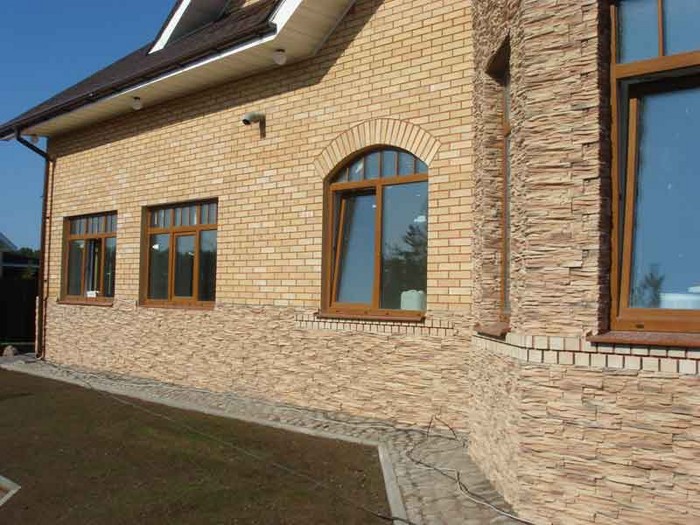
Facing the facade with a stone is always beautiful. Long lasting and reliable material creates an incredible effect, even if the house is very small and just an economical frame frame. Regardless of whether natural or fake diamond applied, the practicality of the material is confirmed by years of use. However, it is worth remembering that this is an expensive and heavy material, so light structures and foundations will have to be strengthened.
As for the practical characteristics, they are at their best: frost resistance, moisture resistance, absence of corrosion - due to the severity of winters in our regions, the material clearly has a lot of advantages. But the price of natural stone makes you think - it is very expensive. Artificial is cheaper, but the cladding process is associated with a lot of work, so when choosing how to sheathe a house from the outside, think over all the nuances: from financial to labor costs.
Plaster
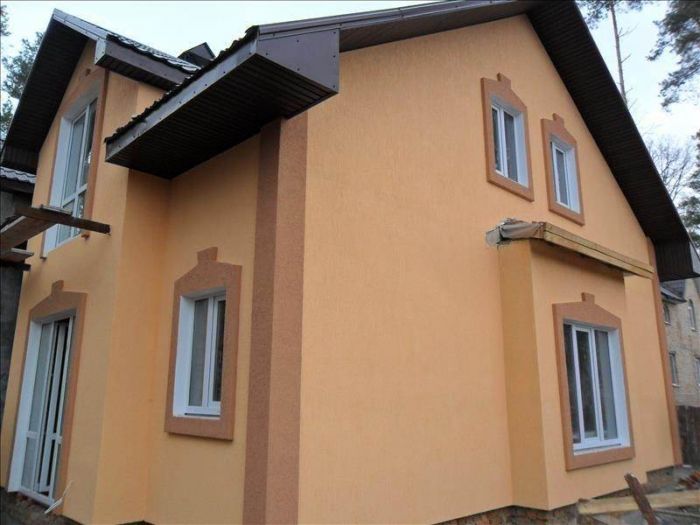
Cheap, practical, aesthetically pleasing, durable - that's what we can say about plaster. It doesn't matter if it is a classic material or a decorative one. The method is considered the most popular, so manufacturers offer a huge range of products with the following qualities:
- Low cost;
- Ease of use and ease of application;
- Huge selection of colors, decorative solutions;
- Excellent heat and sound insulation performance;
- Improving the refractory qualities of the structure;
- The coating dries quickly, is not afraid of shocks, water;
- Variability of mixes and finishing technologies.
So, facade plaster. It can be both smooth and textured:
- Mineral plaster... Inexpensive and common material. Differs in bio-resistance to fungus, not afraid of moisture and direct sunlight.
- Acrylic materials have increased elasticity, are not susceptible to cracking during shrinkage processes at home. The durability of the cladding and the preservation of its aesthetic appearance are also a plus, and resistance to frost, moisture and water add up to the benefits. But such plaster gets dirty quickly, is flammable, therefore it is not shown for finishing facades where thermal insulation is made with mineral wool.
- Silicate plaster- it is one of the most durable, durable and practical. The facing product does not lose its aesthetic and practical qualities for a very long time, does not get dirty and can be easily cleaned with ordinary washing. There is only one caveat - the plaster needs to be applied quickly, while it is damp. This requires at least a minimal mastery of skill, therefore, it is not always possible to do the work efficiently with your own hands. In addition, there is not a wide variety of colors and textures.
- Silicone plaster Is a new product that can be used to quickly and easily cover the facade of a building. There is only one drawback - it is expensive. But if you need a "hardy" finish that is not subject to corrosion, is flexible during natural shrinkage processes, does not lose its color, withstands corrosion, mechanical shock and at the same time is not afraid of water, frost, sun and snow - the right choice. Such plaster always remains clean, even if the house is located next to an oil refinery. At the same time, the ease of application is beyond praise.
Ventilated facades
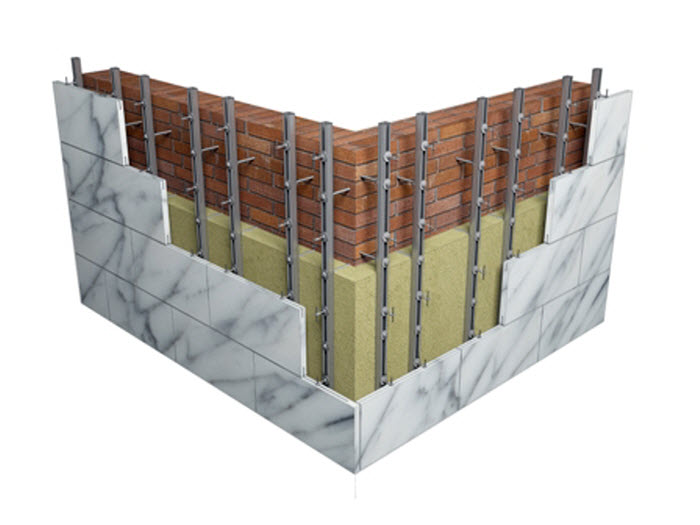
The cladding option resembles a layer cake: a gap remains between the final finish and the insulation. From itself, the structure is hinged sheets, mounted at a certain distance from the wall panels. By keeping the facade of the house from environmental influences, the finishing option increases energy efficiency, reduces the threat of moisture accumulation, and increases the strength of the entire structure. In the case of choosing this particular cladding option, any materials are suitable for use: aluminum composite sheets, heavier slabs - there is no difference if the facade and wall panels can withstand an additional load.
Giving preference to the ventilation facade, the owner receives the most even panels without the need to level the walls, high elasticity of the finish during the processes of natural shrinkage of the structure, an aesthetic appearance and additional protection of the house.
Siding
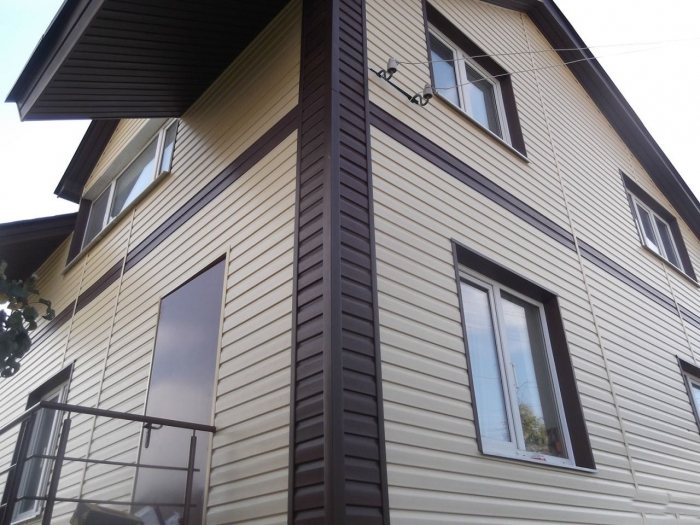
Another extremely popular and inexpensive material used everywhere. There are many types of products that are suitable for cladding, very rarely metal, but it is better to use it for industrial buildings. The advantages are obvious: this material is flexible, economical, easy to install, has no drawbacks and is extremely cheap! The artificiality of the appearance is concealed by the merits, so more and more often the owners make a choice in favor of siding.
The decorative panels are mounted on a pre-assembled batten, which is quick and easy to do on your own. The possibilities of decor are not limited by anything: the profiles are made with imitation of natural materials, they are smooth and textured, but you need to take into account the linear expansion of the material with increasing and decreasing temperature. Variety of species:
- Vinyl - light weight PVC panels capable of imitating various materials natural and artificial origin.
- Wooden - keeps warm well, beautiful, but expensive and short-lived.
- Metallic has disadvantages in the form of corrosion.
- Cement slabs are heavy slabs that are difficult to install alone.
- Plinth - thicker panels designed for heavy loads.
Wet facade
Multi-layered finishes where each part plays a role. Wet cladding facades have three layers: base with reinforcement, heat-insulating, decorative. The first layer evens out the walls, the second adds energy efficiency, the third decorates. A mesh is mounted on the facade, on which an adhesive mixture is applied to fix a sheet of insulation, and then a decor made of silicone or mineral plaster.
Block house
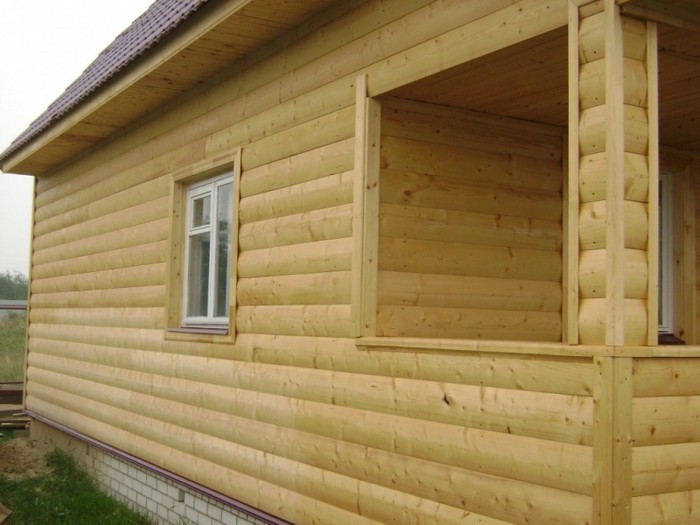
This is one of the more expensive finishes. A lining is used that imitates a rounded log. For all its practicality and beauty, the material is short-lived, while it has all the characteristic drawbacks natural wood... Of course, decorating your house with a block house means getting a presentable mansion, but the slightest distortions in the technology of drying the product will lead to damage to the cladding already in the first year of operation.
In addition to the high cost, the block house requires constant care and timely impregnation with antiseptics, antiprenes.
Facing brick, clinker tiles

For the production of the material, high quality natural clay is used and the sintering technology is applied. Therefore, the products are frost-resistant, environmentally friendly, resistant to water and other aggressive influences. But at the same time, the expensive price of the material makes you think.
A long service life, ease of installation with your own hands are pluses, but the mandatory strengthening of the foundation when using bricks is a minus.
Facade tiles
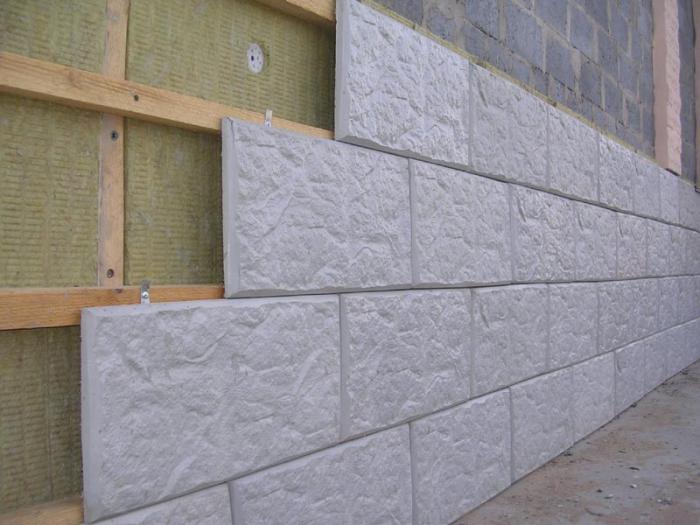
If you want to get a high-quality finishing layer and at the same time buy material inexpensively, finishing decorative tiles will fulfill all requests. The cladding will serve for more than a dozen years, remaining all the same beautiful and durable.
Important! So that the installation of tiles does not cause problems, it is necessary to prepare the surface of the walls, carefully leveling and priming them.
The laying technology is simple, grouting will also not cause problems, but you will have to choose between small-format and large-format material. It all depends on how much time the owner is willing to spend on decorating the house: the choice in favor of small-format tiles is a more aesthetic look, but large-format elements fit faster, require less mortar. But small tiles are easier to replace in case of breakdown.
We talked about the most popular finishes. After looking at the photo, the user will find answers to many questions. But you should not dwell only on the proposed methods, there are a lot of types of decor that turn out to be more expensive, but no less aesthetic: porcelain stoneware slabs, brick, stone tiles, cassette facades - all this deserves attention and reflection. If you already have to clad the facade of your house, think over and weigh all the possibilities before deciding which material is better.
It is likely that lining with euro lining on a pre-assembled frame will be the most convenient, practical and inexpensive way, and stone chips are already perfect for lining - an expensive material, but very practical and giving the house an exceptional individuality.
Ideally, the materials for finishing the facade should be determined at the design stage of the house. This is important from the point of view of the appearance of the building, its compliance with the landscape composition, as well as with practical point vision - what material is needed to cope with the task of sound insulation, insulation, wall protection?
General requirements to facade cladding of all types are the samee: it must be resistant to the appearance of mold and mildew, hygienic, moisture resistant, capable of withstanding wind and mechanical loads, temperature extremes.
Here we will consider the most worthy cladding materials that meet all these requirements.
Advantages of facing bricks- a beautiful surface, which can be glazed or decorated, as well as a wide range of colors - a variety of dyes are used in production, resulting in a beautiful facing material.By strength facing brick comparable to the usual one. Their main difference is not physical characteristics, but the exterior, which is reflected in the cost of the material.
The siding is quick and easy to install thanks to the special panel structure.
Disadvantages: only metal coatings resist mechanical stress well, and the price of fasteners is quite high.
Composite facade cladding
This concept unites many materials, multicomponent in composition. It can be a combination of cement and clay, cement and fiberglass, wood flour and polymer resins. The meaning of such a mixture is that the components complement each other's properties and the result is obtained. Composite materials are widely used to create siding cladding.Disadvantages: depending on materials. For example, aluminum is "cold", porcelain stoneware is heavy, fiber cement has a fairly high moisture absorption, etc.
Sandwich panels are ventilated facade panels. Not the cheapest option, but convenient and multifunctional, thanks to it the final cost finishing works can be significantly reduced. Another advantage is maintainability: if one panel needs to be replaced, then it is not necessary to remove the entire casing, and the place of replacement will not stand out. Suitable for both new homes and renovations.Disadvantages: depending on the material.
Natural stone is cut into tiles, bricks, etc. and is used for wall cladding. Facades, decorated with natural stone, they are very beautiful, they are warm in winter and cool in summer.
decorated with natural stone, they are very beautiful, they are warm in winter and cool in summer. Disadvantages. Natural stone is very expensive. In addition, it exerts a serious load on the load-bearing wall, and specific qualifications are required to work with it.
Facade cladding with artificial stone
It is cheaper and more variable than natural, and its qualities are minimal. You can choose panels that imitate absolutely any stone - from shell rock to granite.Disadvantages: durability and resistance to external influences less than natural stone.
An ideally smooth and geometrically flawless material that receives high strength characteristics due to firing. Consists of clay, fluxes and dyes.UV resistant tiles, bacteria, mechanical stress, chemistry, moisture, easy to clean and fit.
Disadvantages: the price is quite high, and the strength is in any case less than that of a brick or stone.
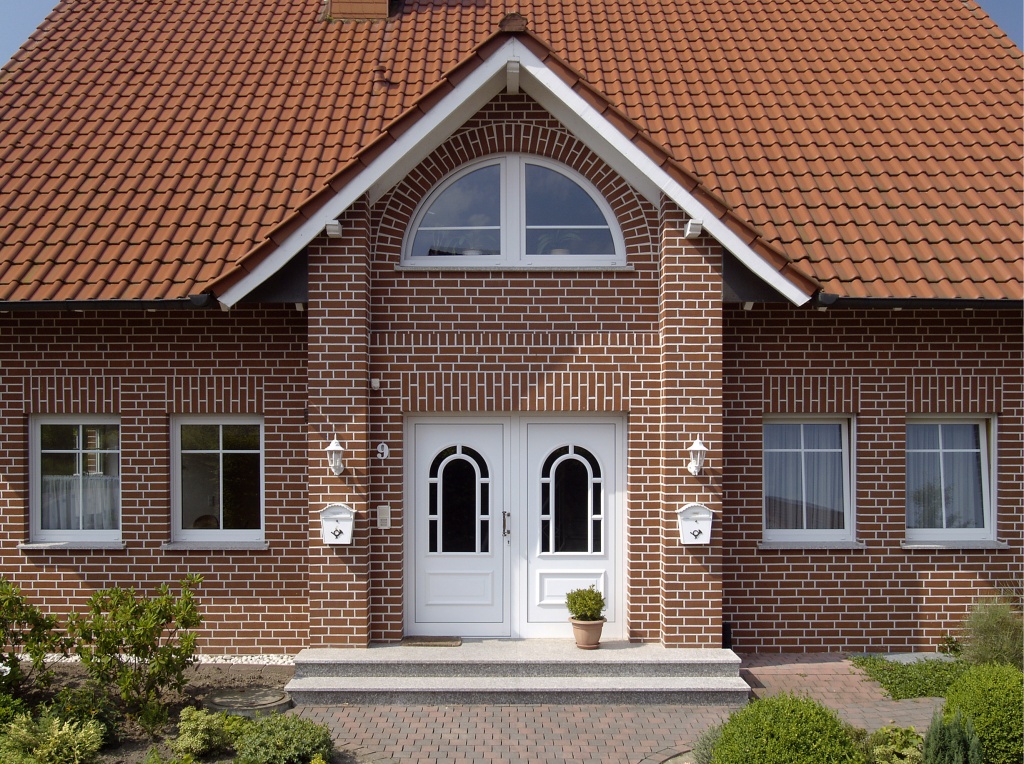
Facing facades with profiled sheet
Used primarily in industrial construction, for finishing public buildings, shopping centers etc. An inexpensive finish that allows align a wall of any curvature, get very beautiful cladding of any shade and transform even the most dull building.Disadvantages: the same type of texture, poor sound insulation, does not protect from heat and cold by itself.
Plastic facade cladding
Another very affordable option especially popular for cladding country houses, temporary buildings and other objects that are not very demanding on the style and aesthetics of the cladding.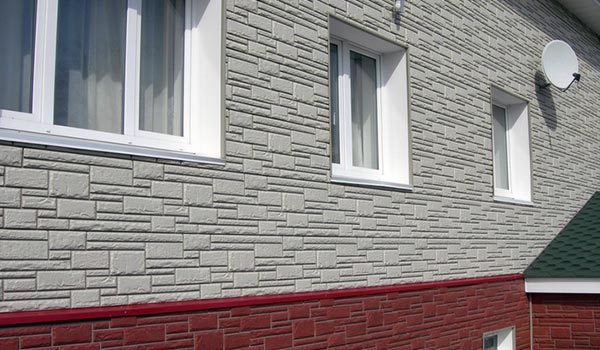
Disadvantages: not very high strength, synthetic origin, not suitable for repair.
As you can see, you can't just say "This is the best material" and just use it for cladding. There are no materials without advantages, there are no materials without disadvantages. It is necessary to take into account climatic conditions, and features of operation, and costs, and the expected service life of the new facade. So the final choice should be made by the owner after consultation with the architect-designer.
What characteristics should the material for facade cladding have, each homeowner decides for himself. Someone cares about fundamental and prestigious appearance, to someone - functionality. Basically, the following requirements are imposed on facade materials:
- appearance (style, possibility of original design)
- durability, resistance to fading;
- ease of installation;
- high level of thermal insulation;
- waterproofing;
- soundproofing;
- environmental friendliness;
- thermal expansion coefficient;
- minimal need for surface care.
Types and features of cladding
Decorative cladding can be applied with or without insulation, glued or nailed. In general, facade materials are divided into two large groups:
- Ventilated facade. When between load-bearing walls and a layer of lining remains a ventilation gap through which air circulates.
- Non-ventilated facade. The cladding material is applied directly to the walls. Most often, several layers are used, consisting of a reinforcing mesh, insulation, primer, plaster or paint.
Another division is by the method of application:
- Dry facade. Some types of materials are mounted with nails or self-tapping screws. For example, lining, facade panels, decorative boards, etc. Such work can be carried out at any time of the year, if the other components of the cladding are not afraid of frost and high humidity.
- Wet facade (finishing with water) is applied using special compounds: glue, mortar, grout. This is how facing brick, artificial or natural stone, porcelain stoneware, decorative plaster are mounted.
The main types of cladding, the most popular today are:
- artificial or natural stone;
- brick;
- decorative panels;
- porcelain stoneware;
- plaster;
- siding.
Each of the named species has several subspecies, which we will discuss in detail.
Stone castle. Prestigious finish
A mansion faced with stone can be called a stone castle because of its noble appearance. Marble, granite, quartzite, limestone, shell rock have been used for many centuries, and they are a solid and reliable finish. If earlier the main disadvantage of stone finishing was weight, and therefore special requirements for the foundation, then with the advent of artificial stone this issue was removed from the agenda. There is only one drawback left - the high cost, due to which this finish is most often used only for the basement of the building.
Attention! Artificial stone is made from sand, cement and dyes and natural stone particles. It is lightweight, which means it can be used for brick and wooden buildings.
Advantages:
- aesthetic appearance;
- exclusive colors and patterns;
- resistance to aggressive environmental influences;
- the longest service life, practically unlimited;
- maintainability, at any time several elements can be glued or replaced.
Disadvantages:
- duration and labor intensity installation works that can only be trusted by specialists;
- the high cost of the material itself and the cladding work.
Facing brick - a modern classic
Brick will always be relevant, not only as the main building material, but also as decoration and protection of the facade of the cottage.

Brick cladding - a timeless classic
Advice. Brickwork should be started 50-70 cm above the ground level to isolate it from snow and moist soil.
The advantages of finishing:
- fire resistance and moisture resistance;
- environmental friendliness;
- long service life;
- does not require additional insulation, because keep warm well.
Disadvantages:
- high cost of materials;
- lengthy installation and increased payment ratio for facade work.
Decorative panels - high-quality ventilated facade
All kinds of panels are one of the most popular cladding methods. They have a stylish appearance, durability, the ability to fantasize with design and relatively affordable prices. It can be installed in any weather, because the material is moisture resistant and does not deteriorate from temperature extremes. They may be:
- Metallic. Manufactured from aluminum or galvanized steel coated with polyester. The only drawback is the low level of thermal insulation.
- Woody. They are made by pressing wood fibers. They imitate natural wood and have good thermal insulation. Weak point - react to moisture.
- Fiber cement boards. Hinged panels from cement, cellulose and plasticizers. Attached to metal carcass imitate any facade material.
- High strength glass panels. They look stylish and are considered an elite finish.
- Foamed polyurethane foam is made from marble chips, foam and other additives.
- SIP panels. Facade sandwich made of several layers imitates any kind of finish.
Stylish and versatile porcelain stoneware
Porcelain stoneware was originally used as a floor covering, but in recent times it is used for finishing office facades and residential buildings... It belongs to the type of ventilated facades and has several types:
- polished;
- technical;
- matte;
- glazed;
- structured.
Porcelain stoneware has collected all the main advantages: fire resistance, strength, environmental friendliness, maintainability. Not afraid of high and low temperatures, mechanical damage. It has many shades and sizes. The only drawback can be called too formal appearance.
Decorative plaster of different textures and colors
A proven method that has found a new face with the use of modern technologies. Plaster, consisting of gypsum, lime mixtures or cement-sand mortars, is applied to any surface, even to a heater with a wet method. The facade mesh is required. Variants and texture decorative coating amaze the imagination: smooth paintable, marble, granite, as well as acrylic, mineral and silicone.

Facing the facade of the house with decorative plaster "like a stone"
Advantages:
- keeps warm;
- prevents water ingress;
- passes steam and air;
- can be combined with other decorative materials such as wood paneling.
Disadvantages:
- labor intensity of finishing works;
- requires renewal once every 5 years;
- in case of staining, the facade is renewed once every 2-3 years.
Democratic and diverse siding
Siding is considered one of the most common materials, with a number of functional and decorative benefits. Despite the acceptable cost, it is strong and durable.
Siding happens:
- vinyl. Panels with a thickness of 1.1 mm have a smooth or textured surface in the form of a "herringbone" or "ship board";
- acrylic from new generation polymers. Differs in a glossy surface and increased resistance;
- basement 16-23 mm thick, imitating natural materials, including stone;
- block house. Panels imitating natural timber;
- vertical siding. A new type of panels with original geometry, visually increasing the height of the cottage.
The advantages of using siding are ease of installation and maintenance, strength and moisture resistance, a variety of colors and textures, affordable prices.

Disadvantage: The cladding is so widespread that it gradually loses its uniqueness.
The choice of one or another material for facade cladding is especially wide in modern building hypermarkets. If you live in the region, then the cost of delivery will pay off thanks to the wholesale prices for the selected material and components required for its installation.
Attention! The individuality of the house can be given not by a unique finishing material, but by a thoughtful architectural project installation of cladding with a combination of different shades.
If you want to save money, then experts advise you to focus on material that you can mount yourself. This way you can significantly reduce the cost of paying all necessary work... But if the installation requires professionalism, it is better to hire specialists, otherwise the alteration will cost more.
A carefully thought-out facade cladding will delight you for many years and even decades.
What to choose for facing the facade of the house - video
 After the completion of the main stages of construction, you need to think about what options for finishing the facade of a private house you can choose. Today the market is replete with various offers that offer a large selection decorative finishing facades. Therefore, finishing can be done in different directions and styles.
After the completion of the main stages of construction, you need to think about what options for finishing the facade of a private house you can choose. Today the market is replete with various offers that offer a large selection decorative finishing facades. Therefore, finishing can be done in different directions and styles.
Until recently, the main conditions were the durability and reliability of the cladding of the house. On this moment there is a significant increase in the requirements for facing materials for the facades of houses.
Main operating conditions:
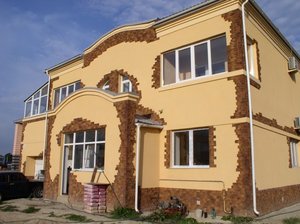
Modern finishing materials for the facades of private houses allow you to counteract any negative factors and at the same time perform a decorative function. Consider the most common facade materials for exterior decoration at home.
Decorative plaster
It is used as a decorative finish for the exterior walls of the house. Experienced professionals, using this finishing material, can create amazing relief planes that imitate natural raw materials.
 Facade cladding with plaster is carried out using cement-sand mixture where there are special additives that provide the surface with good protection. To decorate the facade of the house, a hydro and thermal insulation device is required, which requires insulation.
Facade cladding with plaster is carried out using cement-sand mixture where there are special additives that provide the surface with good protection. To decorate the facade of the house, a hydro and thermal insulation device is required, which requires insulation.
The most popular today is wall decoration bark beetle. Modern technology makes it possible to achieve excellent results in the shortest possible time. For this, manufacturers offer to purchase a ready-made dry mixture in bags or a solution in buckets. Finishing with bark beetle is carried out simultaneously with the insulation of the outer walls.
As a decorative treatment of the updated wall, they use different types acrylic-based paints - this makes it possible to maximize surface protection, and also creates an external durable coating.
Clinker tiles and cladding bricks for the facade
New finishes may show modern materials made from refractory grades earth clay... During production, the clay is subject to heat treatment at elevated temperatures... Due to this, the facing brick is durable and durable.
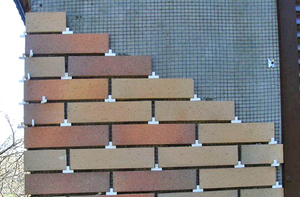 Moreover, such a brick has a number of basic merits: environmental friendliness, heat resistance, ease of care and variety of shapes. The surface is rough, glossy, matte or has an antique design. Various range of colors makes it possible to use facing bricks for decorative finishing of plinths and facades of private houses, to combine decoration around arched openings, entrance or interior doors.
Moreover, such a brick has a number of basic merits: environmental friendliness, heat resistance, ease of care and variety of shapes. The surface is rough, glossy, matte or has an antique design. Various range of colors makes it possible to use facing bricks for decorative finishing of plinths and facades of private houses, to combine decoration around arched openings, entrance or interior doors.
Brick finishing will make it possible to solve the following problems:
- protect load-bearing walls from bad weather;
- give the facade a unique and beautiful look;
- insulate the house additionally;
- hide construction defects.
Finishing bricks have everything quality required for finishing building materials for external work:

Facade masonry with this material is heavy and therefore it is necessary to bring a foundation under it. During new construction, the width of the foundation is made taking into account the width of the cladding. In an already finished building, you need to additionally equip the foundation.
A natural stone
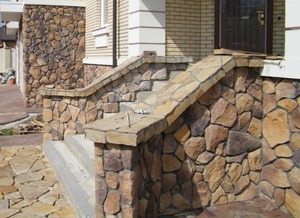
As a rule, natural stone is faced ground floor, but there are often cases when completely external walls are finished with this material country houses or in combination with other types of cladding materials.
Facing external walls with natural stone is:
- protection from bad weather;
- high quality;
- strength;
- beautiful appearance for a very long time.
The following natural minerals are used for decoration:
- Marble- this is one of the most expensive materials for decoration, but at the same time it is easy to process, and also has a large palette of shades and colors.
- Granite- the most popular stone for exterior decoration of houses. Its distinctive feature is its durability and high strength.
- Quartzite- a fairly hard mineral, which differs from the rest by the dissemination of quartz grains.
- Basalt- similar in characteristics to granite.
- Slate- one of the cheapest representatives of natural cameos, found use in external decoration due to its layered and original appearance.
- Sandstone- easy to sand, rather soft and porous mineral.
- Limestone- for external work, its denser types are used.
Facing with natural stone
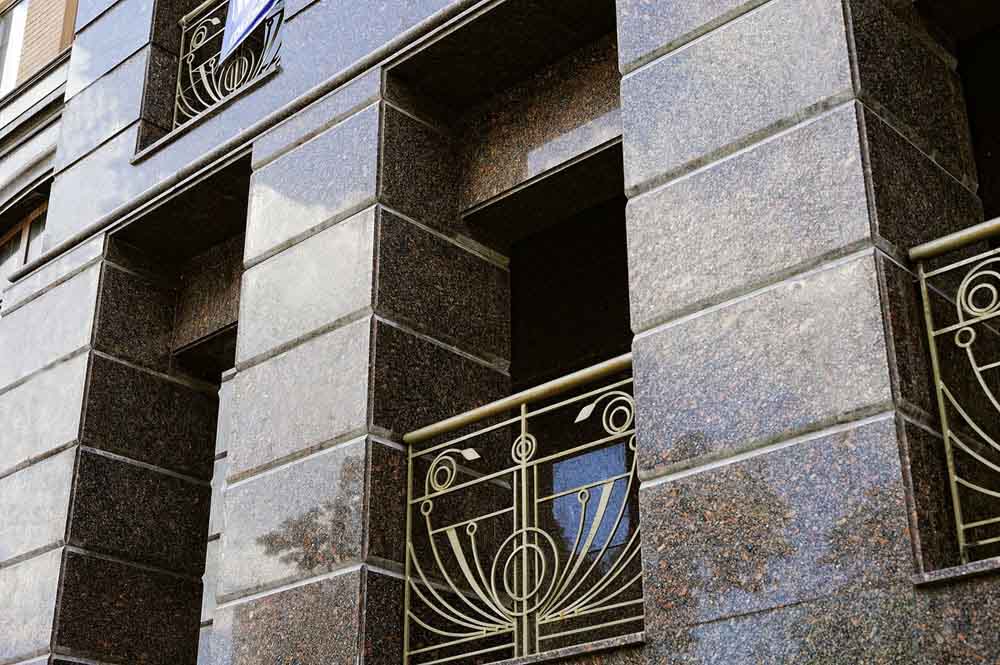
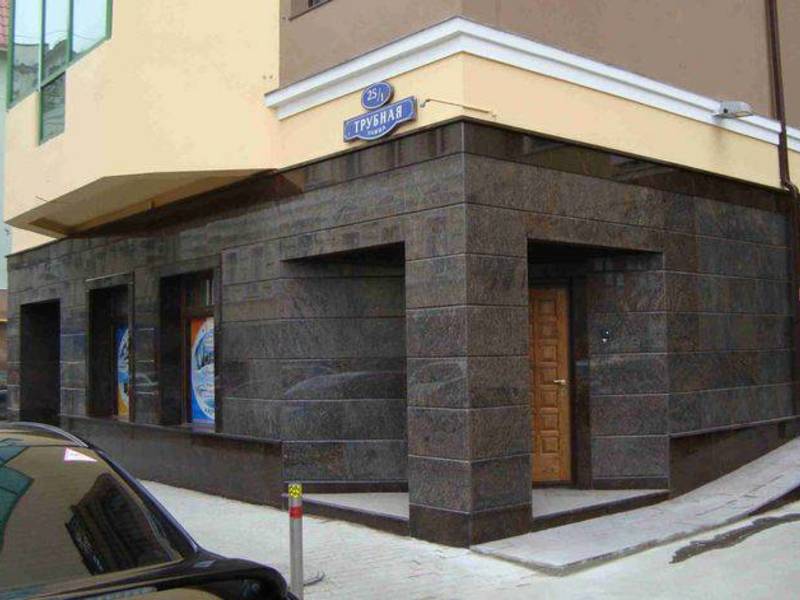
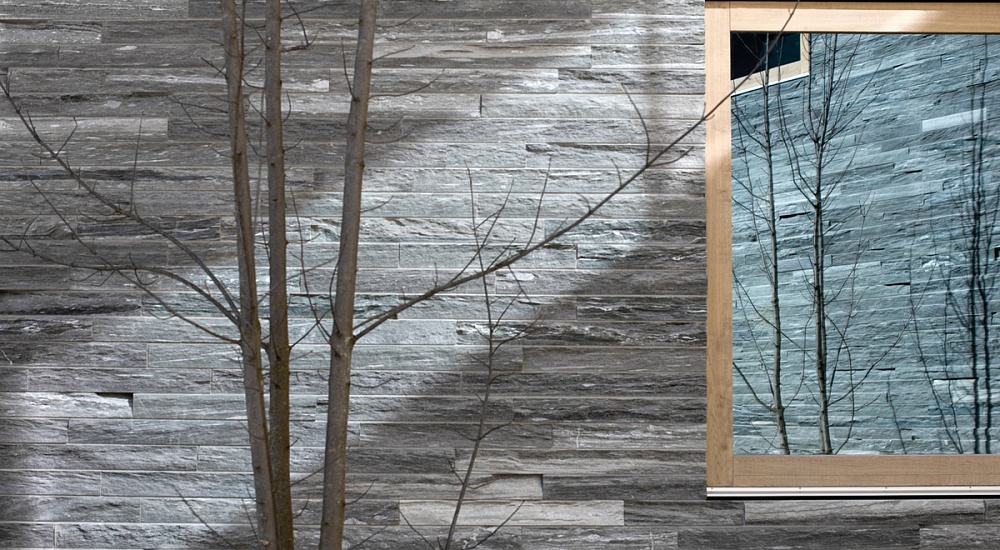
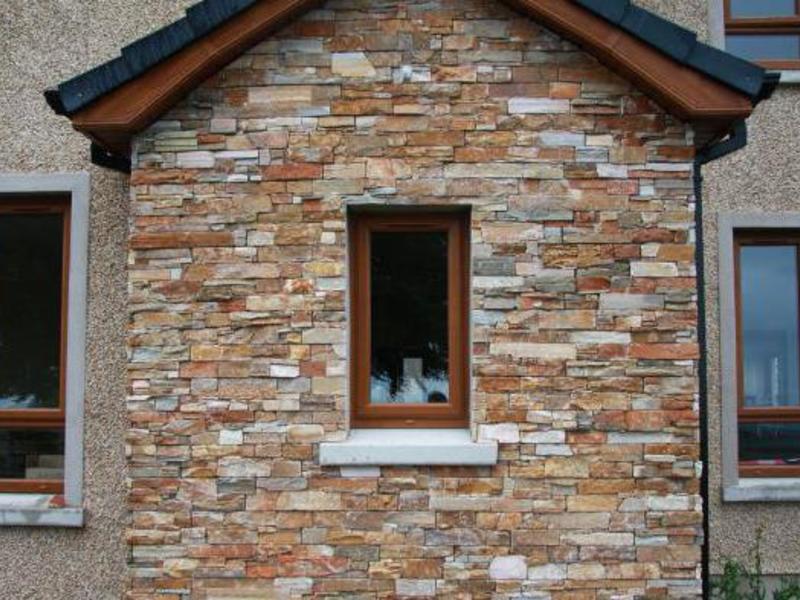
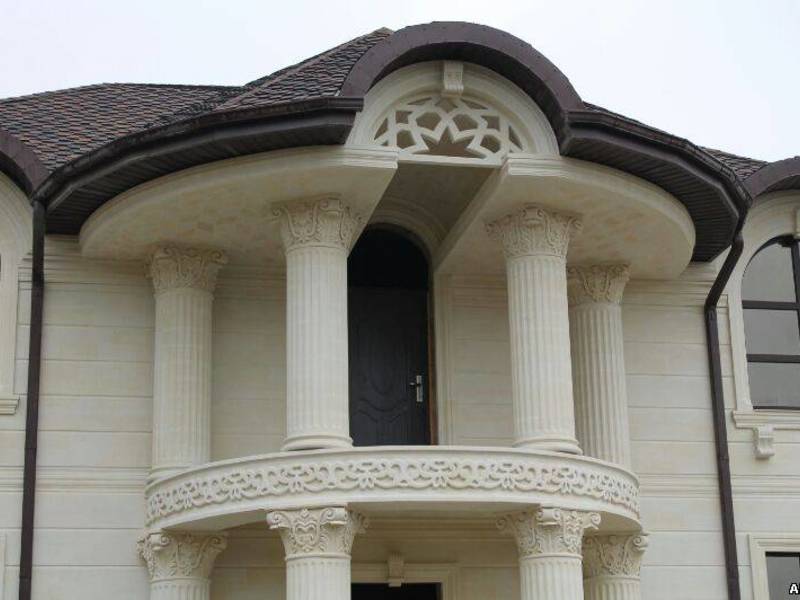

Fake diamond
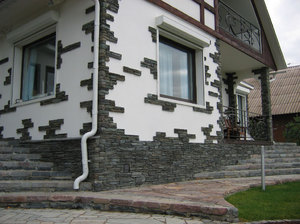
This material has appeared on the market relatively recently. At the moment, artificial stone is widely used for cladding the facades of private houses, since it is very difficult to distinguish it from its natural counterpart in appearance. It is popular due to inexpensive cost, ease of installation and almost unlimited decorative properties.
It includes:
- polymer concrete;
- urea or acrylic resins;
- different dyes;
- cement.
Binder polymeric materials improve performance and increase strength. When choosing a given material for decoration, you need to find out its composition. Certain polymers are harmful to health.
Siding
Of all the types of siding produced by the industry, only two are used for facing facades: wood and vinyl.
It is the most versatile. It is used for the arrangement of ventilated facades. Its main advantages:

- This is a kind of wooden lining, which is made not from solid wood, but from wood fibers pressed using different resins.
This material differs from its vinyl analogue by the following properties:
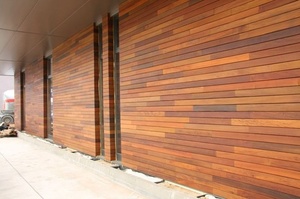
Porcelain stoneware
it durable facade building material made from artificial raw materials by pressing powder from slip with further firing at high temperatures. This facing material has gained great popularity due to the presence of certain positive qualities in porcelain stoneware.
Firstly, porcelain stoneware reacts poorly to mechanical external actions and has a huge supply strength.
Secondly, the attractive appearance of the bricks of this material is excellent for external wall cladding. The base can imitate different tree species, natural stone, or have rainbow stains, bright colors.
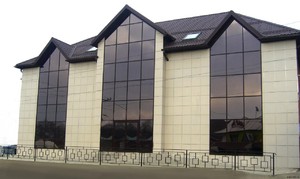 Facade decoration of houses with porcelain stoneware is done in several ways:
Facade decoration of houses with porcelain stoneware is done in several ways:
- Wet styling- the material is fixed to the surface of the walls with special glue;
- "ventilated facade"- the plates are firmly fixed to the frame made of aluminum or galvanized guides.
Which option to choose, everyone decides for himself.
Panels for finishing facades of private houses
The choice of panels is simply striking in its variety. Certain varieties are used by designers to decorate home interiors. All types of facade panels have their own installation method, size and design.
Consider the most popular panel options:
- fiber cement- the textured surface makes it possible to perfectly imitate various materials, for example, tiled, stone and brickwork or decorative plaster... The panels are made of cement with the addition of synthetic fiber and loose cellulose. They are very durable and hardly fade;
- metal- are made of galvanized metal sheets, on which a polymer coating is applied in a small layer. The polymer layer has a bright color and different relief, this makes it possible to create an original combined version using a profile;
- SIP panels- this material, by its properties, is an insulating multilayer panel. SIP panels in their composition have insulation, which is surrounded on both sides by OSB sheets. The layers are bonded to each other with a special polyurethane adhesive. Expanded polystyrene is used as a heater;
- OSB panels- the composition of waterproof plates contains molten ceresin or paraffin. The material is made in large sheets, so you can cut the panels required to size right on the spot;
- wooden- modern boards are made of wood fiber, which is pressed under high pressure; the material contains polymer compounds. This facing material has an excellent surface and light weight, and is also decorated with natural veneer. The operating time is shorter than that of similar slabs, but at the same time its cost is much cheaper, which makes it possible to periodically replace the panels and profile.
Varieties of panels
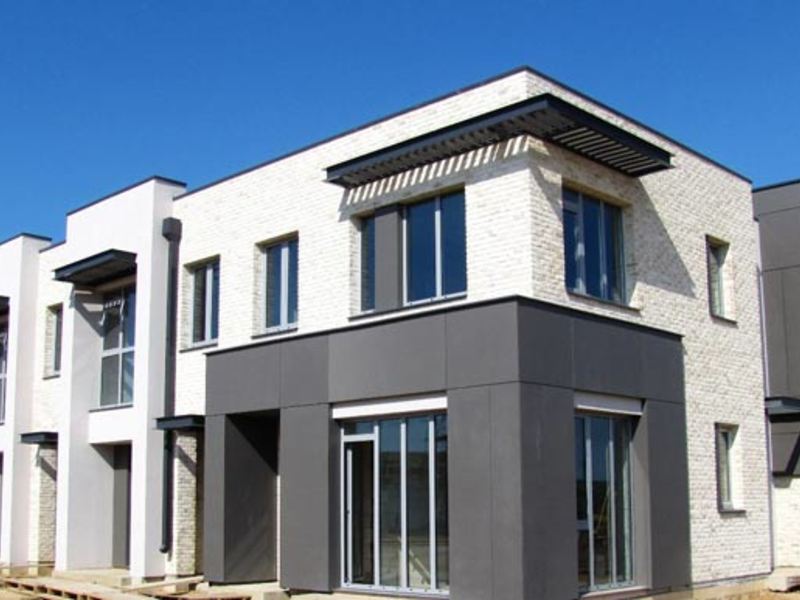

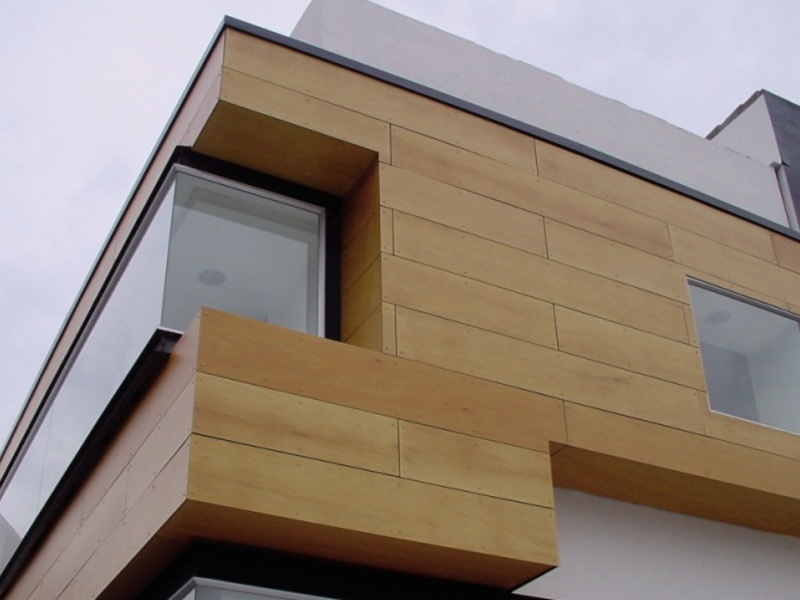

SIP panels are characterized by excellent sound insulation and the best degree of thermal insulation. The low mass of the structure makes it possible to use SIP panels for different bases, in certain cases even a shallow one is enough strip foundation... These panels are weakly responsive to the actions of an aggressive external environment. Due to the use of SIP panels, a classic "Finnish" house can be built in a few weeks.
 This construction consists of a certain number of layers. Moreover, these layers are called heat-insulating, adhesive, protective-decorative and reinforced. They all have their own purpose.
This construction consists of a certain number of layers. Moreover, these layers are called heat-insulating, adhesive, protective-decorative and reinforced. They all have their own purpose.
Facades of this type have a large area of use due to the fact that all components are perfectly combined with each other and can show good results, high vapor permeability, water resistance, frost resistance.
Wall cladding by type " wet facade»Needs some skills, therefore it is not necessary to do this laborious work with your own hands, it is advisable to turn to professionals, only in this case you can extend the life of the material for a long time and achieve good results.
Wood
Today, wood wall cladding is gaining more and more popularity. Outer part a building that is finished with a bar or board has many advantages and positive qualities:
- moisture resistance;
- environmental friendliness;
- original design;
- ease of care;
- durability.
 A house that is faced with natural timber or planks will last much longer if you choose the right type of wood. Experts recommend giving preference only to the wood that grows in your region. This is necessary because these trees are much cheaper than their foreign counterparts and are better adapted to weather conditions.
A house that is faced with natural timber or planks will last much longer if you choose the right type of wood. Experts recommend giving preference only to the wood that grows in your region. This is necessary because these trees are much cheaper than their foreign counterparts and are better adapted to weather conditions.
How will the construction of a residential building be carried out and what is the best choice for finishing the facade? The choice always remains only for the owner. In this case, you need to take into account a large number of nuances: from the economic side of the issue to the technical capabilities of the house. Only taking into account all of the above conditions, you can be sure that the facade cladding of a private house will be durable and of high quality.
Let's talk about secrets ...
Have you ever experienced joint pain? And you know firsthand what it is:
- inability to move comfortably and easily;
- pain during or after exercise;
- discomfort when going up and down stairs;
- inflammation in the joints, swelling;
- unpleasant crunching, clicking not on their own;
- unreasonable and unbearable aching pain in the joints ...
We ask you to answer the question: does this suit you? How can you endure such pain? How much money have you already "poured" on ineffective treatment? It's time to end this! Do you agree? Today we publish an exclusive interview with Professor Dikul, in which the doctor revealed the secrets of getting rid of joint pain, treatment of arthritis and arthrosis.
Attention, only TODAY!

